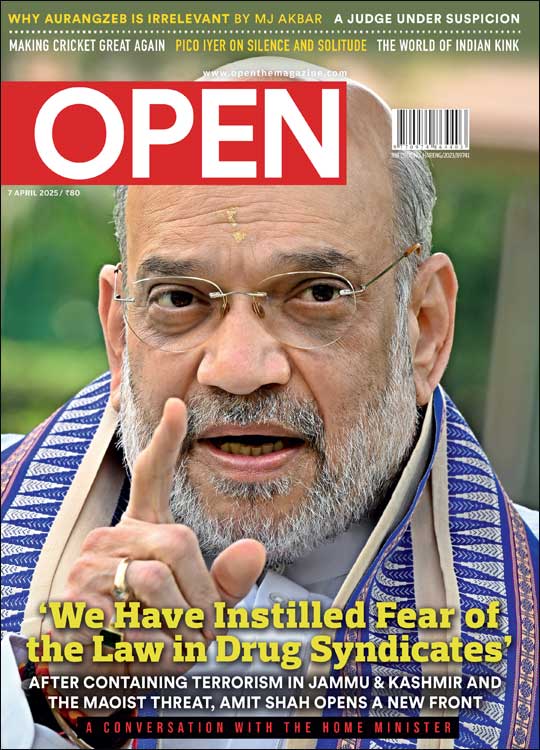How We Valued Value
Wealth is a neglected domain in our scriptures because they were written by brahmins and that is also why artha is intertwined with dharma
 Bibek Debroy
Bibek Debroy
 Bibek Debroy
Bibek Debroy
 |
05 Nov, 2015
|
05 Nov, 2015
/wp-content/uploads/2016/01/20004.howwevalue.jpg)
कर्मण्यवाधिकारस्ते मा फलेषु कदाचन This is a famous shloka from the Bhagavad Gita. “You indeed have a right to the action, never to the fruits.” In advancing a proposition that Hinduism is concerned more about the world hereafter and is concerned relatively less with material prosperity in the present world, this shloka is also cited.[1] If the fruits are irrelevant, why should I be motivated to do anything? Why should I try to improve my material prosperity? Let me instead focus on the world hereafter. It so happens that this is not a shloka from the Bhagavad Gita, it is half of a shloka, from shloka 2.47, the 47th shloka in the 2nd Chapter. The remaining half of the shloka, often not quoted, is as follows. मा कर्मफलहेतुर्भूर्मा ते सङ्गः अस्त्वकर्मणि। “Never should action originate because of the fruits. Nor should you be attached to lack of action.” With both halves of the shloka taken together, one forms a slightly different impression. In discussing Hinduism, with its immensely huge corpus, and attitudes of Hinduism towards specific topics, one must therefore be careful in quoting selectively. What’s the point of quoting half a shloka, without considering the rest of the Bhagavad Gita? How can one quote from a text, ignoring the context of who it was composed for and by whom? Not to speak of issues about when it was composed.
The word वर्ग (varga) means category or class. Used in the sense of an objective or purpose, the three objectives or vargas of human existence are धर्म (dharma), अर्थ (artha) and काम (kama). These are ”पुरुषार्थs (purusharthas), the objectives of human exertion. Strictly speaking, there are four purusharthas, not three—the fourth being मोक्ष (moksha). Moksha can be translated as emancipation, liberation, freedom, release. There are eighteen पर्वs (parvas) in the Mahabharata. In this context, the word parva means part or section. One of the longest of these 18 parvas is Shanti Parva, the section that is about peace. Bhishma hasn’t yet died. He is lying down on the bed of arrows and Shanti Parva, and the subsequent Anushasana Parva, constitute his teachings to Yudhishthira and his brothers. A sub-section in Shanti Parva is titled Moksha-Dharma-Parva, Chapters 168-353 in the Critical Edition [2]. In this sub-section, there is a conversation between Krishna Dvaipayana Vedavyasa and his son, Shuka, where Shuka asks his father and preceptor about moksha. This is what Vedavyasa says. “A being is bound down through deeds and is freed through knowledge…However, a person who obtains knowledge reaches the spot where there is no reason to grieve. Once one goes there, one does not die. Once one goes there, one is not born. Once one goes there, one does not decay. Once one goes there, one does not increase.” This is the sense in which moksha is usually understood, a state where an individual is freed from the cycle and bondage of death and rebirth and karma. Indeed, this is precisely what happens to Shuka. He is liberated and emancipated in that sense. But if one reads the Mahabharata, is that the sense in which the word moksha is used?[3] The Mahabharata was not only about exceptional people like Shuka. It was also about people concerned with this world, people who had to deal with dharma, artha and kama, not only about moksha, interpreted as liberation from the cycle of life. The Bhagavad Gita has 18 chapters and the titles of each of these chapters is qualified by the use of the word योग (yoga).[4] Only one of these titles uses the word moksha and this is the 18th chapter, titled मोक्षसंन्यासयोग (moksha-sannyasa-yoga). If one reads through this entire chapter, there is not a single instance of the word moksha being used in the Shuka sense. Instead, the entire argument is about detachment, even when one is engaged in dharma, artha and kama. Without deviating from the subject and going off on a tangent on a discussion of moksha, there is a simple point being made. Who has said that Hinduism is about the other-worldly pursuit of moksha in a Shuka sense? That’s a selective and subjective reading of some texts. It isn’t a proposition that should be advanced as a sweeping generalisation.
What about dharma, artha and kama? Kama refers to desire, not necessarily to sexual desire alone. Vatsayana’s Kama Sutra, one in a long line of works on kama, is illustrative. It is often understood to be a documentation of sexual positions. Yet, sexual positions account for only one of its seven major segments. In Chapter 3, there is a reference to 64 kinds of arts an accomplished maiden should be familiar with. This has little to do with sexual positions or even sex and probably has more to do with artha. Dating texts is always difficult and so far, we haven’t said anything about time-lines. Vatsayana’s Kama Sutra could have been anywhere between 400 BCE and 200 CE, though there were similar texts of an earlier vintage. To return to the point, kama is about the senses, not exclusively about sex. Nor does dharma necessarily mean religion and should never be translated as religion. In different contexts, dharma can mean good conduct, jurisprudence and rule of law and customary practice. It can also mean the metaphysical. Of the three purusharthas, artha is the easiest to pin down. It means material prosperity and wealth.
One must follow the principles of dharma in earning artha. As we have said, dharma has multiple meanings. Often, dharma is understood as वर्णाश्रम dharma, that of the four varnas and the four ashramas. The four varnas mean ब्राह्मण, क्षत्रिय, वैश्य and शूद्र. For instance, the first half of 4.13 in the Bhagavad Gita states, चातुर्वर्ण्यं मया सृष्टं गुणकर्मविभागशः Later, in 18.41 and subsequent shlokas, it goes on to state that the duties of brahmanas, kshastriyas, vaishyas and shudras have been divided in accordance with their nature, their strengths and their qualities. The tasks of brahmanas are naturally driven by qualities of serenity, self-control, austerities, purity, tolerance, uprightness, knowledge and faith. The tasks of kshatriyas are naturally driven by qualities of valour, energy, fortitude, dexterity, not running away in battle, donations and lordship. The natural duties of vaishyas are agriculture, animal husbandry and trade. The natural duty of a shudra is servitude. In any society, there is a functional division in terms of who does what. That’s specialisation and division of labour. In terms of who does what, this part of the Bhagavad Gita doesn’t clearly tell us what brahmanas and kshatriyas are supposed to do. It is specific only for vaishyas and shudras. But there is no dearth of texts that tell us what brahmanas and kshatriyas are supposed to do, more specifically and there is no inconsistency across them. Manu Samhita, one of the Dharmashastra texts, is an example.[5] In 1.88- 91 we are told, brahmanas are supposed to teach, study, perform sacrifices, officiate at the sacrifices of others, give alms and receive alms. Kshatriyas are supposed to protect people, perform sacrifices, study and donate. Vaishyas will engage in agriculture, animal husbandry and trade, lend money, study, perform sacrifices and donate alms. Shudras will serve the other three varnas. Not only is the varna issue controversial, there are too many generalisations around it. Consider the issue of interest rates. This is a quote from 8.140-142 of the Manu Samhita, as translated by G Bühler.[6] ‘A money-lender may stipulate as an increase of his capital, for the interest, allowed by Vasishtha, and take monthly the eightieth part of a hundred. Or, remembering the duty of good men, he may take two in the hundred (by the month), for he who takes two in the hundred becomes not a sinner for gain. Just two in the hundred, three, four, and five (and not more), he may take as monthly interest according to the order of the castes (varna).’ This seems to suggest an annual interest rate of 15 per cent. However, it can also be 24 per cent for brahmanas, 36 per cent for kshatriyas, 48 per cent for vaishyas and 60 per cent for shudras. The interest rate is ostensibly graded according to the varna. Contrast this with a quote from the Artha Shastra. [7] ‘An interest of a pana and a quarter per month per cent is just. Five panas per month per cent is commercial interest (vyavahariki). Ten panas per month per cent prevails among forests. Twenty panas per month per cent prevails among sea-traders (samudranam).’ [8] In Sanskrit, the word dharma is used and an interest rate of 15 per cent per year is in accordance with dharma. As with several words in Sanskrit, व्यवहारिक can have multiple meanings. In this context, it does mean commercial. Hence, compared to the normal interest rate of 15 per cent, the commercial rate of interest is 60 per cent. The word कान्तारग is more difficult to translate. It does mean one who has gone to a forest, but has the nuance of someone who journeys through a forest or a wilderness. In such cases, the interest rate is 120 per cent. Finally, that 240 per cent is for those who undertake sea voyages. In Kautilya, there is no reference whatsoever to interest rates being linked to varna. A journey through a forest was riskier than an ordinary commercial venture. A sea voyage had greater uncertainty than a journey through a forest. The Kautilya scale was hence a risk premium added to the usual commercial rate of interest and nothing more. Who were the people who were likely to engage in trade and undertake voyages through forests and seas? Clearly those who engaged in trade, that is, vaishyas. Ipso facto, the interest rate, with the risk premium added, was likely to be higher for vaishyas than for brahmanas or kshatriyas. We are not quite discussing the interest rate now. This was more in the nature of an illustration. There is a difference between interest rates being linked to a functional occupation and being linked to varna per se. In generalising about varna, this is worth bearing in mind.
Several other caveats about presuming the tight compartmentalisation across the four varnas of brahmanas, kshastriyas, vaishyas and shudras are in order and for our purposes, we can ignore the tangential point about varna also referring to complexion. Manu Samhita (such as 5.16-18) has a listing of permissible diet for brahmanas. This has fish like पाठीन (sheat-fish) and रोहित (rohu carp) and the flesh of animals like porcupines, hedgehogs, iguanas, rhinoceros, tortoises and hares. Who caught the fish? Who hunted and killed the animals? As the duties of brahmanas, kshatriyas, vaishyas and shudras have been described, it couldn’t have been any of these four categories. Of course, Sanskrit has words like धीवर for a fisherman and व्याध for a hunter. But where are they in the four-fold classification? Chapter 4 of Yajnavalkya Smriti has a long list of names of children who are born as a result of the father and the mother belonging to different varnas. When the offspring of mixed parentage inter-married, the taxonomy became finer and finer and more and more complicated. Since the Dharmashastra texts spent such a great deal of time on the semantics and taxonomy, inter-varna marriages must have been fairly common, despite the avowed intention of marriage and children within the same varna. The more interesting question is a different one. Were these professions earmarked for these offspring because their fathers and mothers belonged to specific varnas? Or did these professions exist and did the ideal or normative system try to fit it into the accepted template by giving all kinds of names to children of mixed parentage? This isn’t a question to which there is a ready answer. If the primary determinant is the functional one of professions, then varna is nothing but specialisation in society and division of labour. However, if the primary determinant is birth or heredity, then such specialisation is not determined by skills of individuals, but by the accident of their birth. Returning to the taxonomy of the four varnas, who created wealth, so to speak? Wealth was created by vaishyas, not by brahmanas. Indeed, kshatriyas did not directly create wealth either. However, most texts that are cited were written by brahmanas and for brahmanas. That being the case, is it reasonable to expect such texts to lay emphasis on wealth creation? If these texts do not lay emphasis on wealth creation, that’s neither here nor there. One small slice establishes nothing about Hinduism’s attitude towards wealth. It is certainly the case that there are few texts directly devoted to vaishyas. However, there are texts on governance and duties of a king, such as Kautilya or parts of the Mahabharata. Those do place emphasis on wealth and don’t ever suggest that artha was alien as an objective. Stated differently, wealth creation was needed to sustain the activities of brahmanas and kshatriyas and the world is no different today.
1 Since a broader point is being made, there is no need to specifically reference such mentions.
2 All references to the Mahabharata are to the Critical Edition. The Critical Edition was published by the Bhandarkar Oriental Research Institute, Poona, between 1933 and 1966. A soft copy of the Critical Edition is available at https://bombay.indology.info/mahabharata/statement.html.
3 This is a point also made by Chaturvedi Badrinath, The Mahabharata, An Inquiry in the Human Condition, Orient Longman, 2007
4 The word yoga means union, but is used in multiple senses in different contexts.
5 It is difficult to date this precisely. Anything between 1250 BCE and 200 BCE is possible, with something like 500 BCE as a reasonably final form.
6 https://hinduism.about.com/library/weekly/extra/bl-lawsofmanu8.htm
7 As with several other texts, there are problems in dating Kautilya’s Artha Shastra. There is a discussion in Thomas R Trautmann, Arthashastra, The Science of Wealth, Allen Lane, 2012. 150 CE is a reasonable date.
8 This is the translation by R Shamasastry, Government Press, Bangalore, 1915, The Arthashastra of Kautilya. This section is from 3.11.01.
About The Author
CURRENT ISSUE
‘We Have Instilled Fear of the Law in Drug Syndicates,’ says Amit Shah
MOst Popular
4

/wp-content/uploads/2025/03/Cover_Amit-Shah.jpg)











More Columns
Elon Musk attracts sharp attack over ‘swastika’ from Indians on social media Ullekh NP
Yunus and the case of a "land locked" imagination Siddharth Singh
Why CSK Fans Are Angry With ‘Thala’ Dhoni Short Post